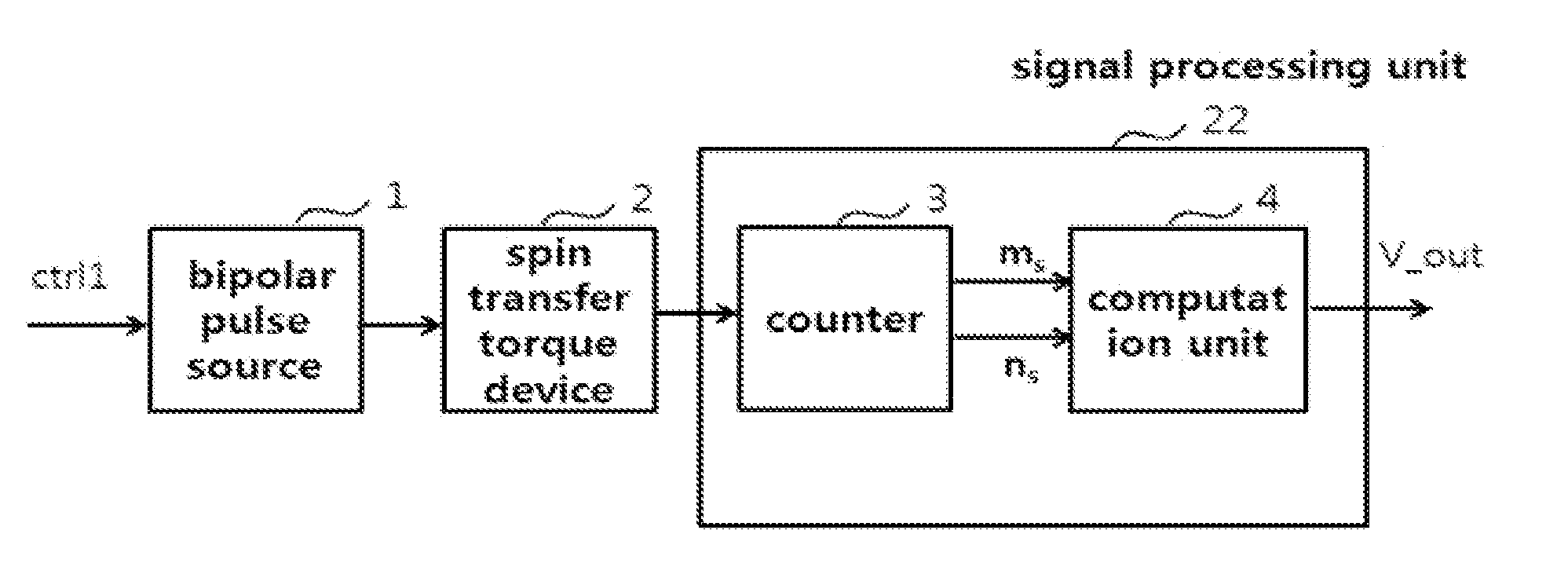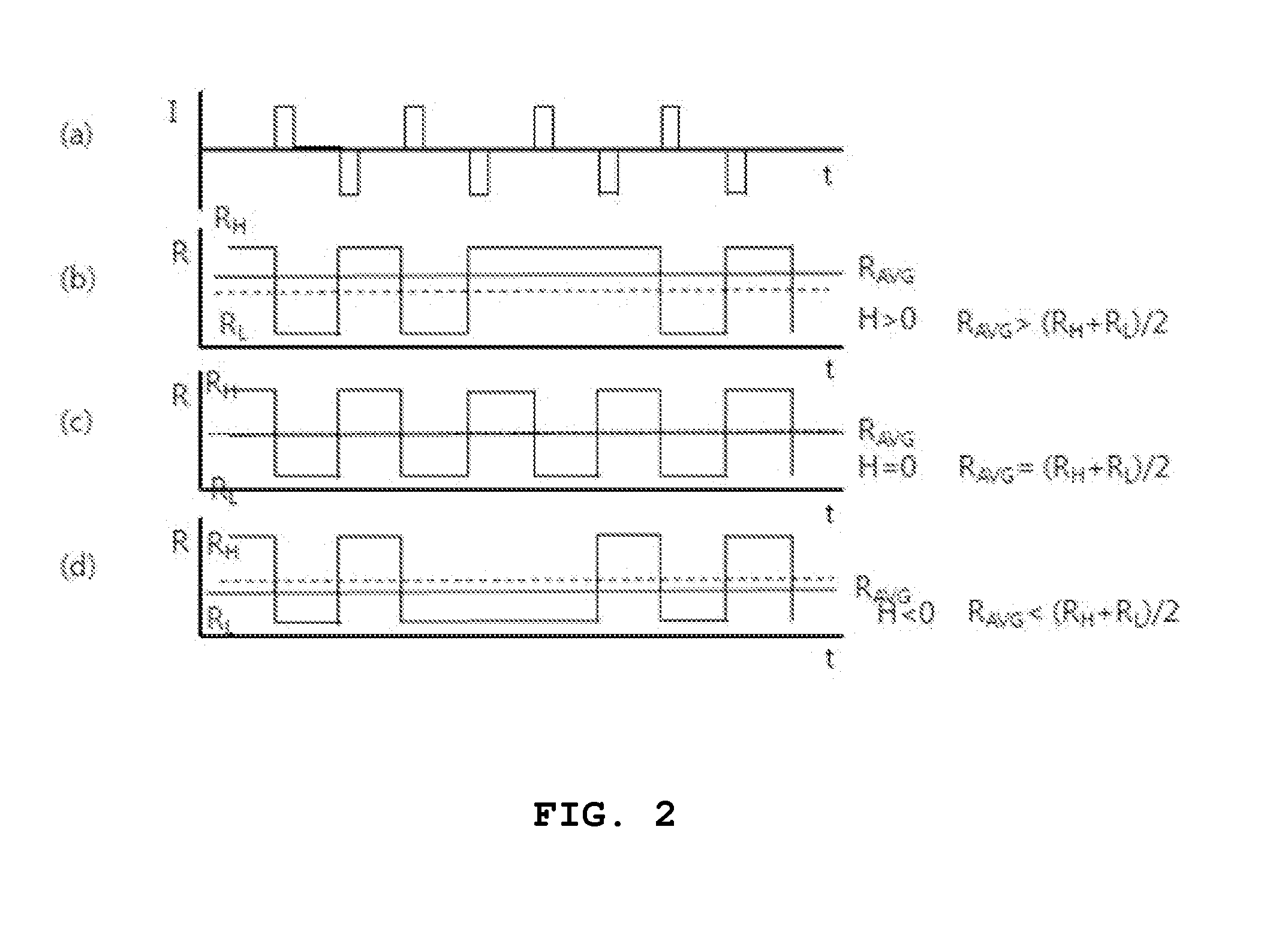Magnetic sensor using spin transfer torque devices
a technology of magnetic sensor and torque, applied in the direction of measurement device, magnetic measurement, instruments, etc., can solve the problems of limited linearity, heat radiation, complex structure of the structure, etc., and achieve the effect of expanding the dynamic range of the magnetic field, searching, and eliminating hysteresis
- Summary
- Abstract
- Description
- Claims
- Application Information
AI Technical Summary
Benefits of technology
Problems solved by technology
Method used
Image
Examples
embodiment 1
4. Embodiment 1
[0054]A method of controlling a coercive field according to the present invention is illustrated in FIG. 6. The magnetic sensor illustrated in FIG. 6 includes a bipolar pulse source 1, a spin transfer torque device 2, and a signal processing unit 22 including a counter 3 and a computation unit 4.
[0055]The bipolar pulse source 1 applies pulses having a positive / negative amplitude directly to the spin transfer torque device 2 in order to cancel out the coercive field of the spin transfer torque device 2, and alternately applies positive / negative pulses. In this case, the shorter the period of the pulses is, the more desirable it is for the linearization of the magnetic sensor. The waveform of the bipolar pulse source 1 may correspond to bipolar sine waves or triangular waves apart from bipolar square waves illustrated in FIG. 2(a). Of the three bipolar waveform examples, bipolar square wave pulses have the lowest power consumption.
[0056]Although the spin transfer torque...
embodiment 2
5. Embodiment 2
[0063]A method of controlling a dynamic range offset according to the present invention is illustrated in FIG. 8. In the magnetic sensor illustrated in FIG. 8, a bias unit 6 capable of applying an offset bias is added to embodiment 1. In the present invention, although the offset of the dynamic range can be controlled by only the offset bias of voltage (current), an exciting wire 7 may be added to extend offset control to a wider region. Furthermore, it may be possible to replace the signal processing unit 22 of FIG. 6 with a low frequency band-pass filter 5. The low frequency band-pass filter performs the function of eliminating high-frequency noise attributable to bipolar pulses and the smoothing function of filtering variations in magnetic resistance value.
[0064]FIG. 9 illustrates an embodiment of the role of an offset bias. When an offset bias is not applied to voltage, a magnetic field proximate to 0 can be detected. When a positive (negative) offset bias is appl...
embodiment 3
6. Embodiment 3
[0066]A method of controlling an output level according to the present invention is illustrated in FIG. 10. A magnetic sensor illustrated in FIG. 10 illustrates that a resistor unit (a resistor network or an attenuator) 8, the resistance level of which is variable, is added in series to a spin transfer torque device 2a. When the magnitude of the resistance is adjusted, the level of an output signal Vout may be determined using the voltage divider rule.
[0067]FIG. 11 illustrates an embodiment in which a spin transfer torque device 2b, instead of the resistor unit 8, has been added in series. The additional spin transfer torque device may be connected in series or parallel, and may vary the level of the output voltage depending on the method of connection. As an example, when the detection direction of a magnetic field of the spin transfer torque device 2b is opposite that of the spin transfer torque device 2a, a push-pull function may be performed.
PUM
 Login to View More
Login to View More Abstract
Description
Claims
Application Information
 Login to View More
Login to View More - R&D
- Intellectual Property
- Life Sciences
- Materials
- Tech Scout
- Unparalleled Data Quality
- Higher Quality Content
- 60% Fewer Hallucinations
Browse by: Latest US Patents, China's latest patents, Technical Efficacy Thesaurus, Application Domain, Technology Topic, Popular Technical Reports.
© 2025 PatSnap. All rights reserved.Legal|Privacy policy|Modern Slavery Act Transparency Statement|Sitemap|About US| Contact US: help@patsnap.com



